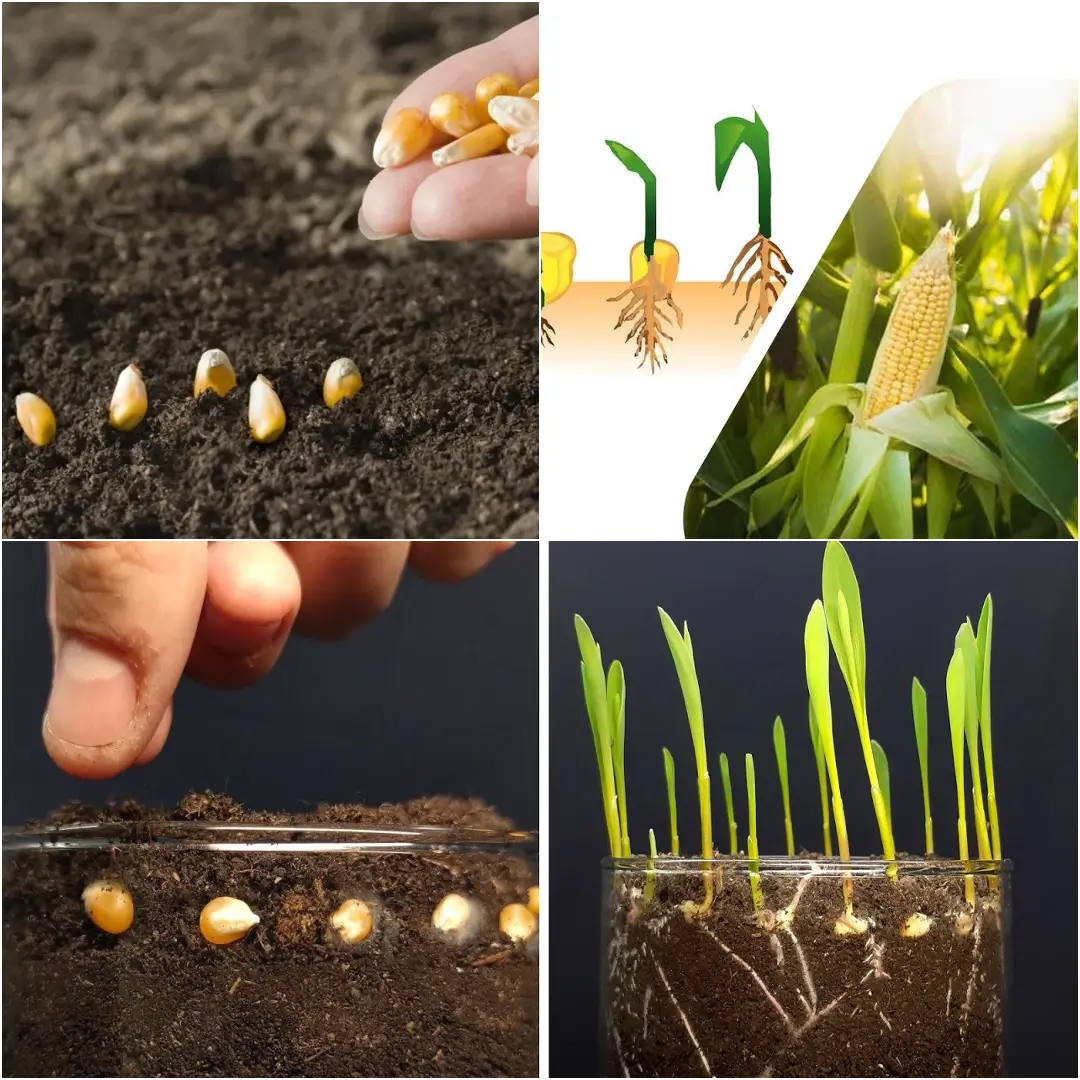Growing corn can be one of the most rewarding experiences in your gardening journey. With its tall stalks and golden ears, corn not only adds beauty to your garden but also provides a delicious crop for you to enjoy. In this guide, I’ll take you through everything you need to know about how to grow corn, from choosing the right variety to harvesting your crop. So, grab your gardening gloves, and let’s dig in!
Understanding Corn Varieties
Before we dive into the nitty-gritty of planting and caring for corn, let’s get familiar with the different types available. Knowing the variety you want to grow can significantly affect your gardening success.
Types of Corn
- Sweet Corn
- This is the type of corn we all love to eat fresh off the cob! Sweet corn has kernels that are typically yellow or white, and it’s perfect for summer barbecues. It’s harvested when the kernels are plump and juicy, making it an excellent addition to salads, salsas, and sides.
- Maize
- On the other hand, maize is often dried and used for making popcorn, maize flour, or even as decorative pieces. Maize kernels can be strikingly colorful and have various uses, making them a versatile choice for both the kitchen and the craft room.
Both varieties share similar growing requirements, but differences in harvesting and storage techniques can affect how you care for them.
When to Sow Corn Seeds
Timing is everything when it comes to planting corn. Since corn is a warm-season crop, you’ll want to pay close attention to the climate in your area.
Season
Corn thrives in warm weather, so make sure you choose a time when the soil temperature is consistently above 60°F (16°C). This typically means planting in late spring or early summer, depending on your location.
Timing Tips
To determine the best time to sow corn seeds, consult a local gardening calendar or agricultural extension service. They often provide guidelines based on your climate zone, helping you identify the ideal planting window.
Preparation for Planting Corn
Before you toss those seeds in the ground, let’s prepare your garden space. Proper preparation sets the stage for a bountiful harvest.
Sunlight Requirements
Corn loves the sun! Ensure your planting area receives at least 6 hours of full sun each day. If you’re not sure about the sun exposure in your garden, take note of where sunlight falls throughout the day.
Soil Requirements
Healthy corn starts with well-drained soil enriched with organic matter. Here’s how to prepare your soil:
- Weed Thoroughly: Remove any weeds that could compete with your corn for nutrients and water.
- Loosen the Soil: Dig up the soil to aerate it. This promotes root growth and improves drainage.
- Add Organic Matter: Mix in aged animal manure or compost. This not only enriches the soil but also helps retain moisture, creating a perfect environment for your corn.
How to Sow Corn Seeds
Now that your soil is prepped, it’s time to sow those seeds.
Seed Treatment
Good news! Corn seeds do not require any special treatment before planting. No soaking or stratification needed here.
Sowing Method
Here’s how to get those seeds in the ground:
- Depth: Sow seeds 15-25mm deep.
- Spacing: Space the seeds 20-30cm apart, and ensure rows are 50-90cm apart. This spacing allows for good airflow and nutrient absorption.
- Soil Moisture: Keep the soil moist but not overly wet.
Germination Conditions
Under optimal conditions (soil temperatures between 16-35°C), your seeds should germinate in 5-14 days. It’s always exciting to see those little green shoots popping up!
Protection
Once your seedlings emerge, it’s vital to protect them from pests, pets, and the elements. This is especially important during their early growth stages.
Sowing in Blocks
Instead of planting in long rows, sow your corn in blocks. This technique enhances pollination, as corn is wind-pollinated, and ensures even distribution of pollen among the plants.
Frost Sensitivity
Be cautious of frost! Corn is a tender crop sensitive to cold. Ensure that all danger of frost has passed before planting your seeds outdoors.
How to Grow Corn
Growing corn is an ongoing process that requires care and attention.
Watering Corn
Watering is crucial to healthy corn plants. Here’s how to do it right:
- Soil Check: Water when the soil is dry about 5cm below the surface. A quick finger test can tell you whether it’s time to water.
- Deep Watering: Water deeply, ideally in the early morning or late afternoon, to minimize evaporation. Avoid watering the leaves to reduce the risk of fungal diseases.
Fertilizing Corn
If you’ve prepared your soil well, you may not need additional fertilizer. However, in poorer soils, fertilizing can help your corn thrive.
- Slow-release Fertilizer: Apply this when transplanting or when your seedlings are 5-10cm tall.
- Liquid Fertilizer: Use this during the fruiting or flowering stage, applying it at the recommended rate.
How to Harvest Corn
Ah, the moment you’ve been waiting for—the harvest! Knowing when and how to harvest corn can make all the difference in enjoying the fruits of your labor.
Harvesting Sweet Corn
Sweet corn is ready to harvest when:
- Silks: The silks at the end of the cobs turn brown and dry.
- Kernel Test: Strip back the husk slightly and pierce a kernel; if the juice is milky, it’s harvest time!
To harvest, grasp the ear firmly and twist while pulling downwards. Sweet corn tastes best when eaten soon after harvest, so enjoy it fresh!
Harvesting Maize
For maize, look for the following signs:
- Silks and Husks: They should be dry and brown.
Use the same harvesting technique as sweet corn. After harvesting, hang or spread the cobs in a well-ventilated area to dry completely for a couple of weeks.
Common Problems When Growing Corn
Like all plants, corn can face its fair share of challenges. Let’s address some common issues you might encounter.
Pests
- Aphids: These small sap-sucking insects can wreak havoc on your plants. Control them by spraying with a hose or using a soap or alcohol spray.
- Pollination Issues: Poor pollination can lead to empty or missing kernels. Ensure you’re planting in blocks and managing insect infestations.
- Slugs and Snails: These little guys love to munch on tender leaves. Control them by removing hiding spots and using traps.
- Caterpillars: Armyworms and cutworms can burrow into your corn. Monitor your fruit and remove any caterpillars you see.
- Animal Pests: Protect your corn from animals like possums and birds by using netting or cages. Alternatively, homemade sprays with garlic or fish oil can deter them.
Growing corn is a delightful journey that can yield delicious rewards. From selecting the right variety to ensuring proper care and harvest, each step is an opportunity to learn and grow as a gardener. So, whether you’re savoring sweet corn fresh off the cob or preparing maize for your favorite recipes, I hope this guide helps you master the art of corn cultivation. Happy gardening!
FAQs
How long does corn take to grow?
Corn typically takes 60 to 100 days to reach maturity, depending on the variety and growing conditions. Sweet corn usually matures faster than maize, so if you’re looking for a quicker harvest, sweet corn is the way to go!
How do you start a corn plant?
To start a corn plant, sow seeds directly into the soil after the last frost date. Make sure to plant them about 15-25mm deep and 20-30cm apart. Keep the soil moist but not overly wet. Ensure that the planting area receives at least 6 hours of sunlight daily for optimal growth.
How to get corn seeds?
You can obtain corn seeds from various sources, including garden centers, nurseries, and online retailers. If you’re looking for a specific variety, checking local seed exchanges or farmer’s markets can also be beneficial. Just ensure you’re selecting high-quality, non-GMO seeds for the best results.
How many corn do you get from one plant?
On average, each corn plant produces one to two ears of corn. However, the number can vary based on the variety, growing conditions, and care. Providing adequate space and nutrients can enhance yields, so don’t hesitate to pamper your corn plants a little!


